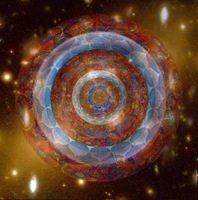Light
.
Light, or visible light, is electromagnetic radiation of a wavelength that is visible to the human eye (about 400–700 nanometre. In a scientific context, the word light is sometimes used to refer to the entire electromagnetic spectrum.[1] (What Is a Light Source?) Light is composed of an elementary particle called a photon.
Three primary properties of light are:
- Intensity, or brightness;
- Frequency or wavelength and;
- Polarization or direction of wave oscillation.
Light can exhibit properties of both waves and particles. This property is referred to as wave-particle duality. The study of light, known as optics, is an important research area in modern physics.
Speed of light
The speed of light in a vacuum is exactly 299,792,458 Metres per second|m/s (about 186,282.397 miles per second). The speed of light depends upon the medium in which it is traveling, and the speed will be lower in a transparent medium. Although commonly called the "velocity of light", technically the word velocity is a vector quantity, having both magnitude and direction. Speed refers only to the magnitude of the velocity vector. This fixed definition of the speed of light is a result of the modern attempt, in physics, to define the basic unit of length in terms of the speed of light, rather than defining the speed of light in terms of a length.
Different physicists have attempted to measure the speed of light throughout history. Galileo attempted to measure the speed of light in the seventeenth century. A good early experiment to measure the speed of light was conducted by Ole Rømer, a Danish physicist, in 1676. Using a telescope, Ole observed the motions of Jupiter and one of its satellites. Noting discrepancies in the apparent period of Io's orbit, Rømer calculated that light takes about 18 minutes to traverse the diameter of Earth's orbit. Unfortunately, this was not a value that was known at that time. If Ole had known the diameter of the earth's orbit, he would have calculated a speed of 227,000,000 m/s.
Another, more accurate, measurement of the speed of light was performed in Europe by Hippolyte Fizeau in 1849. Fizeau directed a beam of light at a mirror several kilometers away. A rotating cog wheel was placed in the path of the light beam as it traveled from the source, to the mirror and then returned to its origin. Fizeau found that at a certain rate of rotation, the beam would pass through one gap in the wheel on the way out and the next gap on the way back. Knowing the distance to the mirror, the number of teeth on the wheel, and the rate of rotation, Fizeau was able to calculate the speed of light as 313,000,000 m/s.
Léon_Foucault used an experiment which used rotating mirrors to obtain a value of 298,000,000 m/s in 1862. Albert A. Michelson conducted experiments on the speed of light from 1877 until his death in 1931. He refined Foucault's methods in 1926 using improved rotating mirrors to measure the time it took light to make a round trip from Mt. Wilson to Mt. San Antonio in California. The precise measurements yielded a speed of 299,796,000 m/s.[2]
Spirituality
The sensory perception of light plays a central role in spirituality (vision, enlightenment), and the presence of light as opposed to its absence (darkness) is a common Western metaphor of good and evil, knowledge and ignorance, and similar concepts.
Mind is a phenomenon connoting the presence-activity of living ministry in addition to varied energy systems; and this is true on all levels of intelligence. In personality, mind ever intervenes between spirit and matter; therefore is the universe illuminated by three kinds of light: material light, intellectual insight, and spirit luminosity.
Light--spirit luminosity--is a word symbol, a figure of speech, which connotes the personality manifestation characteristic of spirit beings of diverse orders. This luminous emanation is in no respect related either to intellectual insight or to physical-light manifestations.[3]
